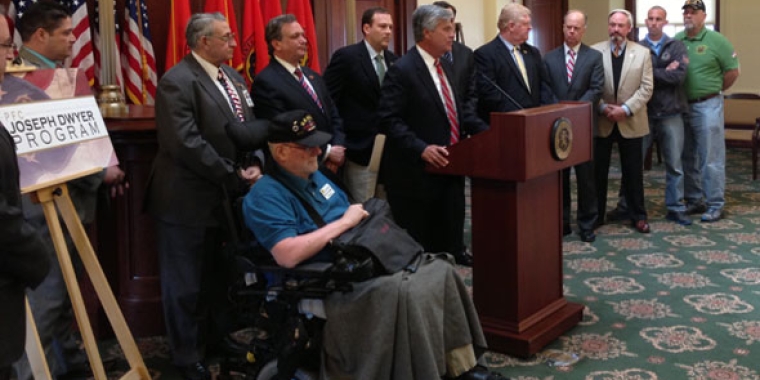
Senate Passes 2015-16 State Budget That Creates a Brighter Future for New York
Dean G. Skelos
March 31, 2015

The New York State Senate today passed a $142 billion 2015-16 State Budget that reflects the Senate’s commitment to strengthening the economy, increasing education funding by $1.4 billion to $23.5 billion and substantially restoring Gap Elimination Adjustment (GEA) cuts, reducing the tax burden on New Yorkers, and creating a brighter future for communities across the state.
Senate Majority Leader Dean G. Skelos said, “This fifth consecutive on-time budget builds upon the progress we are making to revitalize the state’s economy and spend only what taxpayers can afford. We included an overall school aid increase of approximately $1.4 billion along with dramatic relief from Gap Elimination Adjustment cuts. When combined with education reforms to further improve student performance, our children will be better prepared to achieve brighter futures. Communities in each region of the state will have opportunities to strengthen their economies and create jobs through tax relief, investments in infrastructure, and workforce development. And important investments in quality health care and natural resource protection will help improve the quality of life for all New Yorkers.”
For the fifth straight year, the 2015-16 State Budget keeps within a two-percent spending cap, rejects tax increases, and turns a $10 billion deficit into a surplus within those five years.
Highlights of the 2015-16 State Budget include:
Giving Students the Resources They Need to Succeed
$1.4 Billion Increase in School Aid: The new budget upholds the Senate’s commitment to providing schools with the resources they need to help students succeed. The new funding – which reflects an increase of hundreds of millions of dollars above what the Executive Budget originally proposed – will fully support important programs and services that help educate our children and ensure they are college and career ready. The $23.5 billion in funding provided to schools will be fairly and equitably distributed throughout the state. When combined with funding for STAR and Enhanced STAR payments to school districts, overall education spending will total nearly $27 billion.
GEA: Thanks to Senate Republicans’ advocacy to significantly reduce the Gap Elimination Adjustment (GEA) – an unfair school aid cut enacted in 2010 by the Democrats who controlled the Senate, Assembly, and Governor's Office – this year’s budget reduces what remains of the GEA cuts by nearly 60 percent. There will be $603 million in GEA cuts restored and the Senate will continue to work towards the full elimination of the GEA once and for all.
Education Reforms: The final budget also includes a blueprint for significant, new reforms designed to improve performance in the classroom, reduce over-testing, promote excellence in teaching, and restructure failing schools.
Helping Homeowners Keep More of Their Tax Dollars
STAR: Senate Republicans led the effort to create the original STAR school property tax relief program for homeowners, fought for creation of the two-percent property tax cap, and initiated the STAR rebate check program which was eliminated by Senate Democrats in 2009.
The 2015-16 State Budget will ensure that millions of New Yorkers and their families see meaningful property tax relief this year. The new budget includes $3.2 billion to help fully fund STAR and Enhanced STAR. In addition, as a result of this budget, homeowners across the state will receive significantly larger property tax freeze rebate checks than they did last year.
Local Savings: The $1.4 billion school aid increase in the new budget – when coupled with ongoing pension and Medicaid reforms that provide savings to local governments – will help reduce the pressure to raise property taxes.
Cutting Taxes, Creating Jobs, and Increasing Economic Growth
The budget controls overall spending growth to below two percent and avoids new tax increases. It continues lowering energy costs and makes major new investments in New York’s infrastructure to create jobs and new economic activity throughout the state.
Bank Settlement Funds: The budget targets several billion dollars in lawsuit settlement funds to help create new jobs throughout all regions of the state by investing in major economic development and transportation projects, expanding broadband access, and more. Highlights include:
- • Upstate economic revitalization projects will receive $1.5 billion to spur economic development and job growth;
• $150 million for economic development projects on Long Island;
• $1.3 billion for the Thruway Authority to include approximately $900 million for the Tappan Zee Bridge construction and $400 million to help prevent a toll hike;
• $500 million to develop high-speed internet access;
• $400 million for health care capital projects in rural communities and encourage mergers between small and large hospitals;
• $315 million for transportation projects in Oswego, Albany, Ogdensburg, and the Bronx;
• $150 million for counter terrorism, disaster preparedness and public safety;
• $150 million for local government restructuring; and
• $50 million to redevelop the state fairgrounds in suburban Syracuse and $50 million for the Southern Tier and Hudson Valley Farm Program.
Downstate Economic Development: Projects in regions not eligible for the $1.5 billion in Upstate economic development funds or the Buffalo Billion will be eligible for $400 million made available to support regionally significant economic development initiatives that create or retain private sector jobs.
Energy Tax Cut: The budget lowers energy costs by continuing the acceleration of the phase-out of the 18-a surcharge on utility bills.
Transportation: The budget provides approximately $7.2 billion in state Department of Transportation capital funds over two years to support state-of-the-art infrastructure to carry people, goods, and services, and to keep the economy moving forward. An additional $4.8 billion will be used to support the operation of public transportation systems across New York State.
Repairing and Replacing Roads and Bridges: The budget includes $1 billion in additional funds repair and replace roads and bridges across the state. This is an increase of $250 million from the Executive Budget proposal of $750 million.
CHIPS: This year’s budget makes a record investment of $488 million to support important local highway, road, and bridge repair projects, including $438 million through the Consolidated Local Street and Highway Improvement Program (CHIPS).
Winter Recovery: Local governments will be getting $50 million to address this year’s severe winter weather that resulted in a significant number of potholes and road surface damage.
Workforce Development: The budget provides $5.6 million for the Workforce Development Institute, $5 million for the Next Generation Job Linkage Program, and supports the SUNY / CUNY Workforce Development Initiative to provide targeted training to help employers refine the skills of their new hires, and enables more experienced employees to upgrade their skills.
Supporting New York Agriculture
The final budget adds more than $12 million to the Executive Budget proposal, restores budget cuts to 33 different programs that support farmers, agricultural technology, research, and includes funding for key components of the Senate’s “Grown in New York” plan to strengthen connections between farmers and consumers who are increasingly looking to buy locally produced foods.
Grown in New York: The budget supports new programs to connect consumers with locally produced products. It includes more than $1 million to develop a series of new farm-to-market hubs to help farmers in regions like the North Country move their products more easily to markets in New York City and other urban centers across the state, new programs to bring more locally produced fruits and vegetables to low-income seniors ($2.3 million) and schools ($250,000), and $600,000 to support the expansion of the successful “Harvest NY” program.
Young Farmers: This Senate program is expanded with increased funding for college loan forgiveness and $1 million to fund grants (up to $50,000 each), and a new business planning program, administered through Cornell’s FarmNet program, to help beginning farmers get on their feet and ensure success. There is also increased support for public school agriculture education, including Future Farmers of America, to encourage the next generation of farmers.
Making College More Affordable
The budget includes major new investments in New York’s higher education system, ensuring strong support for tuition assistance programs, public and private universities, and community colleges across the state.
Increased Support for Community Colleges: The new budget provides a $20 million increase for SUNY and CUNY by increasing full-time equivalent (FTE) funding by $100. Base aid will be $2,597 per FTE for the 2015-16 Fiscal Year.
Tuition Assistance Program (TAP): The budget increases funding for TAP by $45 million from last year, helping thousands of young New Yorkers afford a quality higher education.
New Scholarships: The budget also establishes a new merit scholarship program, with $500 scholarships going to 5,000 eligible students.
Creating Healthier Communities
The budget restored $21.3 million – 15 percent – in reductions proposed in the Executive Budget to support 41 critical public health programs, and funding included:
- • $25.3 million for Cancer Services Programs;
• $26.3 million for Nutritional Information for Women, Infants, and Children;
• $9 million for chronic disease prevention (including diabetes, asthma and hypertension);
• $2.3 million for the Prenatal Care Program;
• $628,000 for Maternal and Child Health, including the Safe Motherhood Initiative;
• $1.8 million for the Prenatal and Postpartum Home Visitation Program;
• $10.6 million for Adolescent Pregnancy Prevention; and
• $283,300 for the Adelphi Breast Cancer Support Program.
The budget included additional funding for the following critical programs:
• $1.4 million for Women’s Health Services;
• $600,000 to implement recommendations of the Senate’s Lyme Disease Task Force;
• $4.6 million in increased funding for Rape Crisis Centers, bringing total funding to $6.5 million;
• $1.5 million in additional funding for the Spinal Cord Injury Research Board to bring funding up to a total of $8.5 million; and
• $2 million in additional funding for the Doctors Across New York Program.
Rural Health Care: In addition to the Doctors Across New York funding, $400 million in bank settlement funds will support health care capital projects in rural communities and encourage mergers between small and large hospitals.
Overdose Prevention: The budget included funding and authorizations to help save lives by allowing Narcan to be administered by trained school employees if an emergency overdose situation takes place at a school.
Support for Seniors: New York’s Elderly Pharmaceutical Insurance Coverage (EPIC) program will be fully funded at $126.5 million to cover the prescription drug needs of seniors. The budget also increases support for a wide array of programs and initiatives that serve seniors, including:
- • $27.8 million for Community Services for the Elderly Program;
• $26.6 million for Alzheimer’s programs;
• $945,000 for Lifespan for Elderly Abuse, Education and Outreach;
• $172,000 for the New York Foundation for Seniors Home Sharing and Respite; and
• $63,000 for the Senior Action Council Hotline.
Support for Veterans: The budget includes $3.2 million for the Joseph P. Dwyer Veteran Peer-to-Peer Program that connects veterans coping with the effects of PTSD and TBI with other veterans in a secure, comfortable atmosphere; $800,000 for post-traumatic stress treatment and support; and funding for additional initiatives that focus on veterans’ needs.
Protecting the Environment
Environmental Protection Fund (EPF): The budget includes an increase in funding for our local parks, and $177 million for the EPF. This is an increase of $15 million over last year and will help ensure clean air and water in communities across the state.
New York State Water Infrastructure Improvement Act: The budget provides $200 million over the next three years in Environmental Facilities Corp. grants to municipalities to repair and replace existing wastewater and drinking water infrastructure.
Environmental Infrastructure: $152.5 million in new funding is provided for additional improvements to flood control, clean-ups, and environmental restoration projects.
Restoring the Public Trust
This budget included an agreement to strengthen the state’s ethics and disclosure laws, improve transparency, and restore the public trust. The legislative and executive branch will now be required to disclose more information about the sources of a public official’s outside income than has ever before been required in state history.
Share this Article or Press Release
Newsroom
Go to Newsroom
Senate Passes Public Safety Legislation
April 23, 2013
Senate Passes Bill to Increase Juror Safety
April 15, 2013